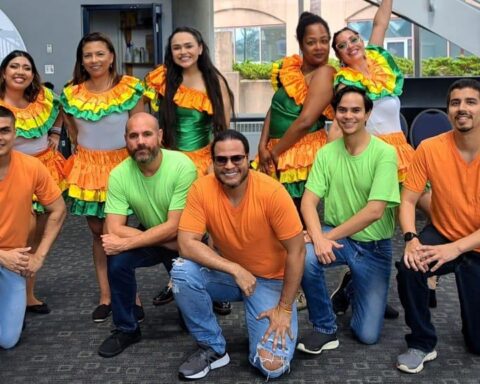Throughout the Canadian provinces, Portuguese-Canadians have been celebrating for the past year the date that marks the beginning of Portuguese emigration to Canada. On the 8th of May 1953, approximately 70 men – 18 from the Azorean islands — said their emotional goodbyes to the city of Lisbon, to arrive five days later in Halifax. They, the pioneers of a new era, followed the steps of forgotten Portuguese heroes, whose presence in Canadian soil dates back to the XV century.
Today, migration accounts for the presence of four million European Portuguese around the world, the majority descendants from the men who left the archipelagos of Azores and Madeira. The story of these first migrants came back to life during a week in Toronto, as Portuguese in this city remembered the tales of their ancestors, and celebrated the achievements of the community as a whole. An exhibition of 40 black and white photographs from May 1953 and the spring of 1954 – some of which are published here – was part of these celebrations in Toronto.
The year of 1953 has a special significance to Luso-Canadians. It represents a turning page in the Portuguese landscape and geography. As it is still today, the majority of migrants that settled in Canada are from the islands of Azores, (Açores).
The Azorean archipelago is a group of nine volcanic islands situated in the North Atlantic Ocean. Its location approximates 930 miles west of Lisbon and about 1,377 miles from St. John’s Newfoundland. These islands, and their Exclusive Economic Zone, (ZEE) are ruled by a self-governing administration, and make up the Azorean Autonomous Region, one of the two autonomous constituencies of Portugal, being the other one the archipelago of Madeira.
In May of 1953, a group of 20 young men from the archipelago “between the ages of 20 and 35 years old, with basic literacy skills (at the time Grade 3), health attested by X-rays, fathering no more than three children, capable of paying emigration expenses and experienced in agriculture,” left the island of S. Miguel, to join other Portuguese from the mainland and Madeira, who forged the way to thousands of men and women who in the next decades would start the Azorean migration saga to Canada. From the original twenty pioneers, two of them were unable to proceed after the medical examinations, and were advised to go to Brazil.
According to a columnist writing in 1953, this small group of Azorean men was an experiment “aimed at demonstrating to the Canadian authorities that Azoreans are reliable and hardworking people, and that they can adapt to any kind of job.” This ‘experiment’ resulted in the sanctioning of more migrants in the spring of 1954. More than eight hundred men from the Azores journeyed to Halifax on the HOMELAND and NEA HELLAS, leaving the motherland, at the time ripped by years of subjugation to landowners, dictatorship, poverty, and the WWII. Women started to join their husbands a couple of years later.
“When we left the islands, many people were poor. When the war came, there were many families with three sons in the army. Soon after, corn, sugar, rice, wheat, butter and other essentials started to disappear. Everything was rationed. In my village there was no doctor and lots of people died without knowing the reasons why. Children’s graves accounted for one-fourth of the cemetery area,” remembers the Bramptonian, Afonso Maria Tavares, one of the 18 pioneers, in his book “Memories”.
ULTRAMAR (colonial) WAR
The Portuguese Colonial War which mobilized 800 thousand men, weighted immensely upon the consciences of many young men and families who wanted to run away from forced circumscriptions. The war was fought between the Portuguese military and the emerging nationalist movements in the African colonies (Angola, Guiné and Moçambique), between 1961 and 1974. Portugal was the first European country to arrive in Africa and the last to leave after the freedom revolution of 1974. According to official numbers this conflict was responsible for the death of 9,000 soldiers, 30,000 wounded evacuated from a total of 100,000 sick and wounded. This conflict, often called the Vietnam in Africa, took the lives of hundreds of young men, whose deaths had a profound impact in many Azorean villages. Today, the unofficial numbers refer to the presence in Ontario of five thousand veterans.
A Door to Freedom
“The first news about Canada came to me from the mouth of Master Antero, a very literate man who liked to read newspapers. It was after Sunday mass, that he told us about the news. We went to look for a newspaper. And there it was written in black and white: whoever wanted to emigrate just had to go to the municipal office to register. Monday morning I left to give my name. I was lucky that my father had a cold, and he didn’t see me getting out of the house. Many young men were slaves to their fathers, and couldn’t do anything for themselves,” told me Armando Vieira during an interview in Montreal, part of a collection of true stories to be published in a book.
“Sometime later,” he continues, “the village cop (this was the name given to the man who would come to the village with news and municipal notices) came to my house. My father opened the door, and of course I had to finally tell him about my intentions to come to Canada. The officer came to tell me that I had to speak with the mayor, and that the people in Canada were free.”
One month after, Vieira gets his okay from the authorities and starts the screening process, which involved rigorous medical inspections. After a difficult and emotional departure from the Azores, Vieira travels to Lisbon, a city he had never visited before.
Arriving in Lisbon
“Lisbon was beautiful from the sea. We disembarked in Alcântra where the emigration authorities waited for us. During the two weeks we were there we had a guide and we visited many important sites in the city.” added Afonso Maria Tavares. In Lisbon, the final steps took place, with the presence of Canadian Inspectors, one of them, Odilion Cormier.
“On the day of the interviews in Lisbon, we were questioned by two Canadians helped by a Portuguese interpreter. The first interview was very long. When the man left he was white like a sheet of paper. We were told not to say if we had relatives in the U.S. The Canadian inspectors were all trying to get the eggs from under the chicken. But we did well. Many of the questions asked were related to our professional background. Canada wanted men that could work the land.”
Vieira is one of the first 18 Azorean pioneers who came to Halifax in the mythical ship Saturnia. Like all the others, the journey by sea takes him from the island of S. Miguel to Madeira, where they stop to load cattle and other cargo, before continuing their voyage to the Portuguese capital.
“I had never been on a ship. The sky suddenly closed it in darkness. The waves jumped high hitting the ship. If we wanted to go to the washroom we had to run. Dishes were flying. One of our guys got really sick with the nerves. The Portuguese Inspector, Ferreira da Costa, was the one who helped him on this journey to Lisbon. My father told me later in a letter that the storm had destroyed all the cultivated areas in my hometown. From Lisbon to Halifax the journey was nice. Men from many other nationalities were there. Mass was in Italian in a small chapel. We danced in a beautiful ballroom to the sound of gypsy music. Gypsies were also on their way to Halifax. Everything was said in Italian. The majority of people in the Saturnia were from Italy.”
Halifax in Sight
“After five days we arrive in Halifax. There we were told where our luggage was, and where to board the train to Montreal. From that moment on, we were on our own. We found a small store where we bought bread and jam and a few other things to eat during the journey. We had a work contract and we knew how much we were going to be paid, but we had no idea who would be our boss and we had no way to communicate with them because we didn’t speak English. Upon arriving in Montreal, we went to the Immigrant Boarding House where we had some rest. After a day the “bosses” came. It was a chock for us. We were there, all sad, without any idea of what was going to happen to us. A man came like it was for an auction. He was a farmer looking for two men. He stared at us and then we were auctioned. I was not sure if he was speaking French or English, and other men came. He kept pointing to this man and that man, and then we left in his car. The handle of my cardboard suitcase had fallen, and I had to carry it on my shoulders. I had no idea where I was going. I was with another pioneer Manuel Vieira. The boss didn’t look at my hands to see if I had calluses from work, as people said the farmeiros (farmers) would. We went to Saint Juliette to work on his farm. On the first night we slept in his house. He had a huge family. After that we went to sleep in what I call a shed, and there we stayed for two months and a half,” adds Vieira.
First Job in Canada
Summer smiled in Quebec. “We started working the land for tobacco. We came with a contract to earn 55 dollars a month, but the boss didn’t pay. Because I was young – when you are young you do a lot – I started to see that he was treating us like slaves. Instead of 8 hours we were working 12, 13 and 15 hours a day. I wrote to the Portuguese consulate about the situation. Soon after, I received a letter stating that if I had paid all our expenses, we were free men to leave.”
With freedom on his horizon, Vieira left the farm with his friend holding a cheque given by the boss. “But the cheque had no funds. Only with the help of a Spanish lady that worked at the Consulate were we able to get our pay.” Like several other of his companions, Vieira’s adventures and hardships do not end here. Many other difficulties make up his whole personal epic, until he finds a steady job and comfort. One year later, these 18 men are followed by the great Azorean migration exodus, with the departure in the spring of 1954 of 330 males on the 22th of March, and 450 on April 24th. They journeyed to Halifax on the HOMELAND. 171 more men followed on the NEA HELLAS. Women started their own saga a couple of years later. In the next few years Canada would receive thousands of Portuguese migrants who are scattered throughout the country.
Challenges in Canada
Today, as Azorean cultural institutions in Canada, such as Casa dos Açores do Ontário, (CAO) situated in Toronto, (http://cacores.ca/), and the thousands of Luso-Canadians in this country who have been celebrating six decades of migration in Canada, challenges arise as young generations are easily integrated, and the stories of these pioneers – as they are called – start to dilute into oblivion. In Toronto, Portuguese migrants began to arrive in the early 1950s, and peaked in the late 1960s and early 1970s.
The 16th Azorean Cultural Week that took place Nov. 3 to 8 in Toronto was one of the many opportunities that the community in 2013 found to celebrate their cultural ancestry. These events are also opportunities to connect with the younger generation, a difficult process, since many do not feel compelled to be a part of existing cultural organizations, as active members. As they leave the traditional Portuguese core – Little Portugal – to move to the suburbs, they logically embrace new values and ways of thinking. Although, the traditional restaurant, the bakery or the Sunday mass still gathers large numbers of Portuguese/Azoreans, the reality is that only the older generations and the thinning number of mature volunteers are still the active forces struggling to keep the institutions running.
In the particular case of the Azores, the Azorean government has had an important role in bridging its communities through a support network that stretches all the way to North America, Bermuda and Brazil – especially Santa Catarina – a place that received an earlier generation of migrants from the Azores, dating back to the XIX century. In the past decade their descendants have started a process of mutual discovery. The existence of weekly direct flights to the Portuguese islands from Toronto, by the Azorean Airline SATA – www.sata.pt – has been responsible for maintaining alive communication links. By financing groups of young Azorean descendants to visit the islands and discover the paradise their grandparents left behind, the government believes that it can keep this emotional bond alive, with returns for all.
Paulo Teves, is the Azorean government official responsible for Emigration. During his latest visit to North America, which took him to California, Ontario, Quebec and Manitoba, to be present at the many events organized by Azorean cultural organizations in Canada, he had once more the opportunity to foster these relationships.
“For us, when we talk about Azores we have to talk about those who are in the islands, but mostly about those who are here. For us it is crucial to keep a bridge between those who left and those who stay. Our work is also very dependent on the dynamic of our communities all over the world. We are keen on promoting a cultural relationship with Canadians, as a means to endorse understanding and the finding of strategies for economic and social growth,” said Paulo Teves in Toronto, before leaving for Winnipeg, where he participated in other events organized by the Portuguese-Azorean community.
Portuguese Language
The maintaining and promotion of the Portuguese language is also an important factor in preserving these links. Ana Tavares Cumbre Ribeiro is the person that coordinates, under the sponsorship of the Camões Institute, the teaching of the Portuguese language in Canada.
“The coordination of the Portuguese studies in Canada is based at the Consulate General of Portugal, in Toronto. Since November 2010, a new language policy has been established. Changes and strategies are being followed in order to promote the Portuguese language and culture not only in the Portuguese community present in this country, but also in a much wider perspective. The challenges are numerous and there is still a long way to go for the promotion of the Portuguese language in such a big and multicultural country as Canada. Here the first, second and third generation numbers 450.000 people the majority lives in Ontario, especially in Great Toronto. The Portuguese language is mostly used in the homes and kept mostly through the conversations with grandparents. There are also some families that use both English and Portuguese at home, although the Portuguese for these children is a rather passive language (they can understand but can’t speak).” says Ana Ribeiro.
The Portuguese language in Canada is offered by private Portuguese schools and by some School Boards, in an extended day system (in Toronto) or on a Saturday program. In Ontario, the Portuguese Language program in the School Boards covers around 6500 students, 5000 of these in Toronto. “We have been offering a plan of professional development for the teachers all over Canada about strategies and different approaches in teaching a second or a foreign language. Updated textbooks and other communicative and interactive resources were produced in Portugal for this purpose.” she adds
New priorities were established and memorandums of understanding were signed with the School Boards “for collaboration between the Boards and the Camões Institute, I.P. “We are also active in the professional development of the teachers, certification, student exchange and development of the Portuguese language program in the secondary level for credits.” The promotion of Portuguese is also done though the organization of cultural activities, in English or in Portuguese, such as lectures, extracurricular courses, exhibitions, films, presence of Portuguese writers (for children and adults) and distribution of books in schools. “We believe that all these different actions will contribute to the promotion of Portuguese as a language of international communication, re-enforcing the importance of a language spoken by more than 250 million citizens in this global world.” adds Ana Paula Ribeiro. – New Canadian Media
Humberta Araújo was born in Vanderhoof, B.C., to parents who migrated from the Azores. As a reporter, she has worked in the Azores and Canada, both in television and newspapers. She is putting together a book on Azorean Migration to Canada. Reach her at [email protected]






Thank for putting this all together. I’m very interested in your book. Please send information on how I can purchase it. Thanks